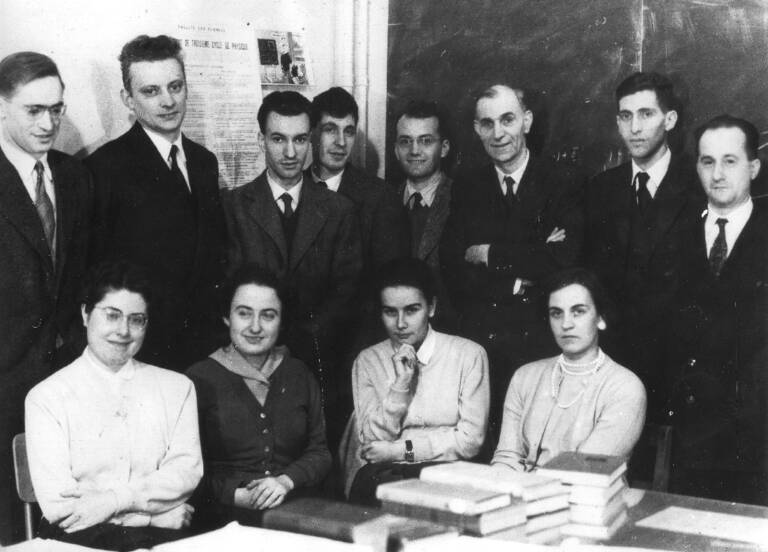- Home
- Laboratory
- Presentation
- History of the Laboratoire Kastler Brossel
- The formation of the group in the fifties
The formation of the group in the fifties

Kastler once asked the photographer from the physics department to capture his research group on film. It was December 1956, in the small usual meeting room (on the first floor, opposite Brossel’s office at that time, which later expanded into the group’s secretariat). In the photo, Kastler and Brossel are seen surrounded by six doctoral students: from right to left: Blamont, Pebay, and Winter, already mentioned; then Jean-Pierre Barrat, who, exempted from military service, began his studies on the conservation of coherence in multiple light scattering, a “parasitic” effect (observed by Blamont) that seemed to extend the lifetime of excited atoms, which Brossel later confirmed in Marie-Anne Guiochon’s diploma.
Regular tea-time discussions with the theorists from the Lévy group provided him with significant motivation to introduce theoretical methods into Kastler’s group that were still unfamiliar at the time. He would calculate this “coherence time,” which was longer than the lifetime of excited atoms. He made this the focus of his thesis in 1959 and soon took a position at the University of Caen; there, he and his wife Mireille Rambosson (the “diplomitive” of the class of ’58) established a Hertzian spectroscopy team in the optical laboratory founded by Pierre Giacomo and Jean-Louis Cojan.
Next to Barrat is Henri Boiteux, who is interested in more traditional spectroscopy topics and would later join the Aimé Cotton laboratory; and all the way to the left is Bernard Cagnac, who had just returned from military service and was preparing to produce the purely nuclear orientation of mercury, already mentioned in Kastler’s 1950 article. The flat, ultra-thin mercury lamps, developed and meticulously filled by expert glassblower Jean Brossel (with impressive quartz seals), enabled him to achieve this, observe the first transient phenomena on the oscilloscope, and defend his thesis in 1960.
In the same photo, seated in the front row, are the female members of the laboratory: in the same order from right to left: Colette Julienne-Galleron, Françoise Boutron-Hartmann, Irène Brodschi, and Marie-Anne Guiochon-Bouchiat. Irène Brodschi remained, until the end of her career at the CNRS, the efficient head of the laboratory’s secretariat, ensuring that everything operated smoothly on a daily basis. The three physicists were just beginning their initial projects at that time, but they represented the first step in a trend of feminization that would continue throughout the history of the laboratory.
Marie-Anne Guiochon completed her diploma confirming Brossel’s intuitions about coherence transfer in multiple light scattering (which would later be definitively established by Barrat’s calculations). After passing the agrégation and spending time in the U.S. to prepare her thesis on the relaxation of rubidium, which she defended in 1964, Marie-Anne returned to the group. Some preliminary studies for various “diplomas” had highlighted the improvement in pumping through the use of buffer gases, which reduce the number of collisions with the walls, or by changing the wall material (coatings of paraffin or silicone). Marie-Anne dedicated herself to the detailed calculation of relaxation effects, meaning all the interactions created by thermal agitation that destroy the order established by optical pumping. She carefully distinguished the various quantum observables and succeeded in verifying and interpreting everything in detail. The other two physicists transitioned to other laboratories after their diploma or third-cycle thesis (Colette in biophysics, Françoise in condensed matter). This photo also omits two absentees who had already completed their first year of “diploma” within the group but were temporarily away due to military service or preparation for the agrégation: Jean Margerie and Claude Cohen-Tannoudji, bringing the total to eleven young physicists associated with the group at that time.
Jean Margerie was tasked with implementing another application of optical pumping, announced in the 1950 article: its application to paramagnetic crystals. To achieve this, he needed to import the usual heavy techniques from solid-state physics into the group, including a cryostat at liquid helium temperature, transparent to light, that could fit into the gap of a large electromagnet providing a high magnetic field. His courage and determination matched the challenge. After defending his thesis in 1965, he decided to choose a provincial career despite all of Brossel and Kastler’s efforts to retain him; he went on to join J.P. Barrat at the University of Caen. Subsequently, he became one of the main contributors to the optics laboratory led by Jean-Louis Cojan, before succeeding him.
Finally, Claude Cohen-Tannoudji collaborated with J.P. Barrat to deepen the quantum theory of light-atom interaction, extending Barrat’s thesis (these are the two reference articles in the Journal de Physique, JP1 and JP2, from 1961). They developed the essential formalism for calculating wave-atom interactions, using the density matrix and its coherent cross terms, revealing complex terms whose imaginary part was interpreted as energy level shifts. Curious to experimentally verify the reality of these “light shifts” in energy levels, Claude Cohen-Tannoudji intentionally produced them in mercury vapor and demonstrated the accuracy of their calculations (which also helped explain the disruptive “light shifts” observed around the same time in the U.S. on hyperfine transitions). This enabled him to defend his thesis in 1962, presenting an overview of the formalism introducing the notion of Hertzian coherence, which would be utilized by all.
Ultimately, the eight thèses d’état mentioned above, along with a good dozen of diplômes d’études supérieures, were necessary to cover everything announced in the two articles from 1949 and 1950. However, it is also important to note the unexpected new findings that were encountered along the way, which were quickly interpreted through Brossel’s intuition, such as multiphotonic transitions and coherence in multiple scattering.
